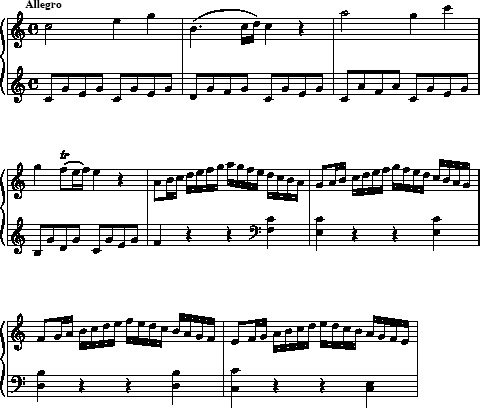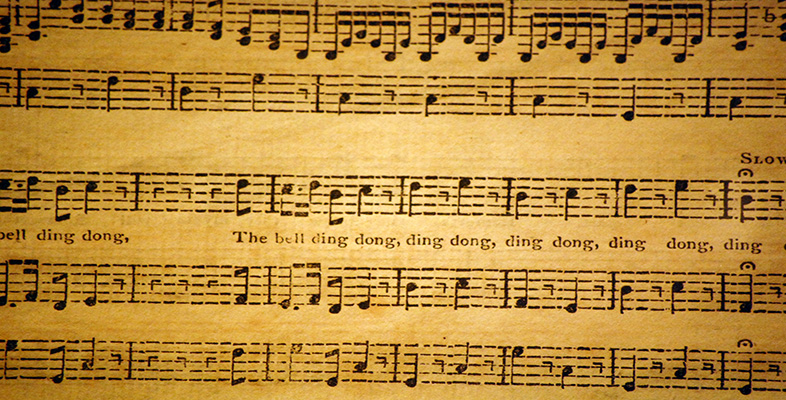3.5 Making a foreground reduction
Now I want you to make your own reduction of the melody and bass lines of bars 1–8 of the Sonata in C major, K545. You may wish first to read through the previous section again, so that you are clear about the different sorts of dissonant notes which are found in tonal music. Then read the whole of the following guidelines carefully before you try this Activity.
Activity 12
Listen to the previous extract, repeated below several more times, while following the music in Example 13 below.
Your task is to write out just the principal harmony notes of the treble and bass, in the manner of my Example 3 at the beginning of this course. To do this, you should print out the sheet of music manuscript paper from the link given immediately below Example 13. Work over your answer on the manuscript paper until you are satisfied that it represents how you hear the overall lines in this extract.
I suggest that you listen to the large-scale lines first in bars 3–4, then in bars 5–8, and then return to bars 1–2. Here are some other things to bear in mind.
-
You need to work out which pitches of the melody are essential to the underlying harmony and which are ‘surface’ events such as passing notes, appoggiaturas and the like. If it helps, feel free to write ‘N’ or ‘P’ over the appropriate notes in the original.
-
When completing this exercise, you will find that the rate of harmonic change is a crucial criterion. This example has an irregular rate of harmonic change. The first chord lasts a whole bar, then there is a change of harmony every minim in bars 2–4, and every semibreve in bars 5–8. Write your reduction in minims (in both treble and bass) for bars 1–4 and semibreves for bars 5–8.
-
For the first minim in the treble line of bar 4, choose the pitch that gives the strongest sense of musical line (remembering that voice-leading analysis is all about large-scale linear movement).
-
Write out each passage in this simpler, skeletal form (this should reveal larger-scale linear formations which we can consider later). Write the passage in two parts – do not bother with the inner parts. Where the left hand part has broken chords (very common in Mozart), only one pitch in each chord will be the true bass note; the other pitches are effectively inner parts.
-
There is no need to write in every single consonant pitch, if you feel that the large-scale lines ‘sing through’ more clearly by omitting some pitches (such as the top C in bar 3, mentioned earlier. This process rather resembles the Activity of writing a variation on a theme, but in reverse.).
-
You may find it interesting to play through your finished result on a keyboard, if you are able to do so. As with the correct reduction in Example 7a earlier, it should make sense as a piece of music, albeit simpler than the original.
Click to listen to extract

Click to open blank staves [Tip: hold Ctrl and click a link to open it in a new tab. (Hide tip)] .
Discussion

Example 14 shows my solution. Do not worry if your result is not identical to mine. Here are some points at which you may have decided to analyse the melody slightly differently from my version.
-
You might have analysed the melody of the first bar differently, keeping the E as the second minim in the treble and omitting the G, or even keeping the C as a semibreve. These would not be straightforwardly wrong as analyses. My reason for hearing the melody as an ascent from C to G is based on large-scale lines in the whole of the phrase. The G is the highest consonant note of the bar, and I think this makes the ear connect this top G with the A that follows in bar 3, giving a smooth sense of line. This connection is indicated by the arrow in Example 14. The same consideration – the influence of large-scale lines – leads me to leave out the top C at the end of bar 3, as I mentioned when discussing types of arpeggiation in Section 3.4 above.
-
Similarly, you might have been tempted to write a minim G in the treble at bar 4. This would be more consonant than the F that follows it. Here, though, I think that the F is truly the main melodic note, because this analysis shows it to be part of a smooth descending line. In addition it forces us, by the very fact of being locally dissonant, to expect the resolution to E over C (which is the goal of the phrase) far more strongly. If you are able, you might like to try playing both versions.
-
You might also have written the semibreve descent A–G–F–E (bars 5–8) an octave lower. This is equally good, as the line occurs in both octaves, filled in by semiquaver runs. My reason for preferring the upper octave will become clear in a moment.
Your analytical reduction may have differed from mine in other ways. In any case, make sure that you understand the reasons why I have favoured the solution given as Example 14 before you continue.
This simple analysis presents a foreground analysis of these bars. The foreground, in analytical terms, means the consonant harmony that makes the actual notes of the musical surface make sense. The analysis also reveals something interesting that may not have been immediately apparent from your initial hearing of the work. In fact, the semiquaver passage (bars 5–8), which seems very different in gesture from the opening four-bar theme, is exactly the same in its underlying voice-leading as bars 3–4. In both cases, as the reduction reveals, there is a large line (which I have marked as motive ‘X’ in my suggested solution) moving downwards from the A, though G and F, to E. In bars 3–4, motive X is supported by the repeated bass note C (which moves down to B and back), and in bars 5–8 it is supported by a bass line which moves downwards in parallel tenths. In effect, Mozart has produced a continuation of his first subject which is nothing less than a hidden variation, rhythmically augmented, of the linear motion of bars 3–4. I point this out at this stage to illustrate just how useful even the simplest voice-leading analysis can be in illuminating hidden aspects of a composer's style, and demonstrating hidden links between parts of a composition which may seem highly contrasted at the musical surface.
